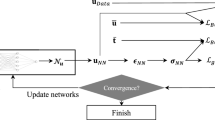Abstract
The natural neighbor interpolation is an interpolation method based on Voronoi diagrams. Since it treats the given data naturally, it has a lot of merits that the finite element method does not have. This fact seems to suggest that the precision of the natural neighbor interpolation is better than that of the finite element method when they are used for function approximation. This paper examines whether this conjecture is true by a numerical experiment. From the experiment, it is observed that the precision of the natural neighbor interpolation is slightly worse than that of the finite element method. This paper discusses the reason why, and concludes that it is caused by an unwanted property of natural neighbor interpolants, which is called the suspension bridge effect in this paper.
Similar content being viewed by others
References
V.V. Belikov, V.D. Ivanov, V.K. Kontrovich, S.A. Korytnik and A. Yu. Semenov, The non-Sibsonian interpolation: a new method of interpolation of the values of a function on an arbitrary set of points. Computational Mathematics and Mathematical Physics,37, No. 1 (1997), 9–15.
H. Edelsbrunner, Algorithms in Combinatorial Geometry. Springer-Verlag, Berlin, 1987.
G. Farin, Surfaces over Dirichlet tessellations. Computer Aided Geometric Design,7 (1990), 281–292.
H. Hiyoshi, An algorithm for computing natural neighbor coordinates. Proceedings of Japan Conference on Discrete and Computational Geometry, Tokyo, Japan, 2004, 63–64.
H. Hiyoshi and K. Sugihara, Two generalizations of an interpolant based on Voronoi diagrams. International Journal of Shape Modeling,5, No. 2 (1999), 219–231.
H. Hiyoshi and K. Sugihara, Improving continuity of Voronoi-based interpolation over Delaunay spheres. Computational Geometry: Theory and Applications,22 (2002), 167–183.
H. Hiyoshi and K. Sugihara, Improving the global continuity of the natural neighbor interpolation. Computational Science and Its Applications—ICCSA 2004 (eds. A. Lagnà et al.), Lecture Notes in Computer Science, No. 3045, Springer, Berlin, 2004, 71–80.
A. Okabe, B. Boots and K. Sugihara, Spatial Tessellations: Concepts and Applications of Voronoi Diagrams. John Wiley & Sons, Chichester, 1992.
F.P. Preparata and M.I. Shamos, Computational Geometry. Springer-Verlag, New York, 1985.
R. Sibson, A vector identity for the Dirichlet tessellation. Mathematical Proceedings of Cambridge Philosophical Society, Vol. 87, Cambridge University Press, Cambridge, 1980, 151–155.
R. Sibson, A brief description of natural neighbour interpolation. Interpreting Multivariate Data (ed. V. Barnett), John Wiley & Sons, Chichester, 1981, Chapter 2, 21–36.
G. Strang and G.J. Fix, An Analysis of the Finite Element Method. Prentice-Hall, Englewood Cliffs, New Jersey, 1973.
K. Sugihara, Surface interpolation based on new local coordinates. Computer-Aided Design,31 (1999), 51–58.
A.H. Thiessen, Precipitation averages for large areas. Monthly Weather Review,39 (1911), 1082–1084.
Author information
Authors and Affiliations
Corresponding author
About this article
Cite this article
Hiyoshi, H. Suspension bridge effect — A consideration about numerical precision of the natural neighbor interpolation. Japan J. Indust. Appl. Math. 22, 233–250 (2005). https://doi.org/10.1007/BF03167440
Received:
Revised:
Issue Date:
DOI: https://doi.org/10.1007/BF03167440



